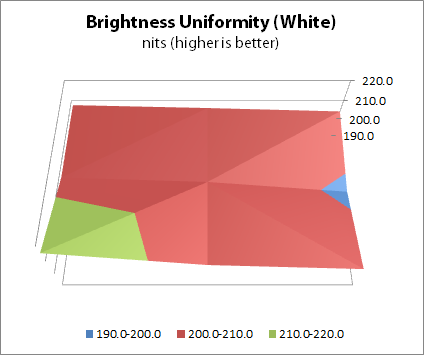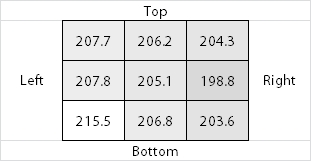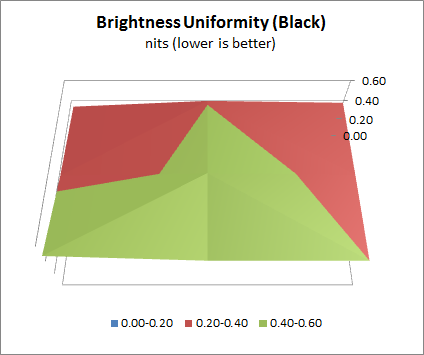NEC PA301w: The Baddest 30-inch Display Around
by Brian Klug on March 1, 2011 8:00 AM ESTBrightness Uniformity
For brightness uniformity, we test at the same 9 points we measure Delta-E on, but this time measure white and black levels when the center point is as close to 200 nits as we can get. We use the same colorimeter and software as before, - an Xrite i1D2 and ColorEyes Display Pro. Similar to the ordinary brightness test (taken at the center), contrast is set to 100 in the OSD and brightness is set to as close to 200 as possible in the center before measurements are taken.
White Uniformity


Black Uniformity


It appears that the PA301w's built-in uniformity settings help keep the brightness profile very steady in the full on white test. There's a tiny horizontal dependence from left to right, but it's imperceptible in practice, and the standard deviation of these readings is just 4 nits. Uniformity in the white department is actually very good.
Blacks are a little worse, again the bottom left seems to be brighter than the rest of the display by a measurable and consistent amount. On the whole again though the consistency is pretty good. Displaying a purely black image, there's also no obvious light leakage anywhere on the display.










92 Comments
View All Comments
Lazlo Panaflex - Tuesday, March 1, 2011 - link
"It's seriously the Ron Jeremy of monitors if there were such a thing."Nah, more like John Holmes....
2 x this beast + AMD 6990 + Crysis2 = boner-rific
MeanBruce - Tuesday, March 1, 2011 - link
Done with the slow funk, so done with Dell out the f'in door end of the driveway pickup! Welcome those beautiful 30inches! ;)softdrinkviking - Tuesday, March 1, 2011 - link
Ryan,In there documentation, NEC claims that their calibrator is factory-tailored to NECs monitors, which seems to suggest that it is more than a "rebranding."
Of course, this could all just be marketing, and they could be the same thing.
Do you know for sure one way or the other?
softdrinkviking - Tuesday, March 1, 2011 - link
Oops. Brian. Not Ryan! Sorry... :)Ryan Smith - Wednesday, March 2, 2011 - link
It's okay. It happens all the time. ;-)Brian Klug - Tuesday, March 1, 2011 - link
From what I've seen, it really does look like a rebranded X-Rite i1D2. It's possible they've done some internal calibration as well (I know a few vendors do things like calibrate the colorimeter). It'd also make sense it's just rebranded since the i1D2 is the only thing that will work with internal monitor calibration.-Brian
eaw999 - Wednesday, March 2, 2011 - link
it's an i1d2 puck, but modified to allow proper calibration of wide gamut monitors.NEC_Art - Wednesday, March 2, 2011 - link
Yes, the NEC calibrator is tuned by X-Rite to more correctly read our MultiSync PA Series wide gamut displays. It is not the same as a retail i1 Display2.Art Marshall
Product Manager, NEC Display Solutions of America
peegeenyc - Tuesday, March 1, 2011 - link
can anyone find this for sale at a major discount retailer?It seems only NEC sell it at full price from my search results.
Azethoth - Tuesday, March 1, 2011 - link
"Apr 12, 2010 2:22 PM in response to: Zeno BokorRe: Photoshop 10bit support
Actually, the 10 bit/channel display path is working quite well in CS5 - on cards and displays that support it.
Again, we've been working with the manufacturers for a while to get it working..."
-Chris Cox (Photoshop lead)
I would be surprised if its the only software that handles 30bit